In 2015, a new credit card security standard was established for American consumers and business owners as a way to protect against credit card fraud. This standard mandated implementing EMV credit cards in our daily retail transactions. EMV stands for Europay, Mastercard and Visa and is a global standard for credit cards. Let me walk you through the basics of what you need to know about these cards.
Why did we move to EMV cards?
 Our financial system switched to these more secure cards because of the increase in large-scale data breaches and the rise in counterfeit card fraud. The year before this new policy was announced, about 31.8 million U.S. Consumers had their credit card information stolen and, in general, almost half of the world’s credit card fraud occurs in the United States. As you can see, it was clear something needed to be done to secure America’s credit card information. That’s where the EMV cards come in.
Our financial system switched to these more secure cards because of the increase in large-scale data breaches and the rise in counterfeit card fraud. The year before this new policy was announced, about 31.8 million U.S. Consumers had their credit card information stolen and, in general, almost half of the world’s credit card fraud occurs in the United States. As you can see, it was clear something needed to be done to secure America’s credit card information. That’s where the EMV cards come in.
What exactly is the chip in my credit card?
The chip in your card is a computer chip. Every time an EMV card is used to make a purchase, the chip creates a unique transaction code that can never be used again. This means, even if a fraudster gained access to that transaction code, they wouldn’t be able to use it to make a purchase because it can only be used that one time.
This is a huge step forward from the magnetic strip on the back of credit cards that we used to use. Those magnetic strips were created with unchanging data, meaning if anyone gained access to the information on that strip, they could copy it again and again and use your information to purchase items.
Why does it take so much longer to make a purchase?
When you “dip” a card into a card reader (inserting your card into the terminal slot), your card’s chip and your issuing financial institution transfer data to verify the card is legitimate and creates unique transaction data that prevents fraud. Patience is key when protecting your information!
Is online shopping more secure too?
Unfortunately, this EMV technology will not protect you when making online purchases. It only protects your information when you are using the chip in an EMV-ready terminal during an in-person transaction.
Although it may seem like a hassle when you’re waiting in the checkout line, the chip in your credit card is helping you keep your credit information safe. As improvements in EMV technology continues, we may begin to see a widespread adoption of contactless transactions, also known as near field communication, or even dual-interface EMV cards.
Want to learn more?
Learn more about EMV credit cards, online and financial security or other steps to reach your financial goals by checking out more Security articles.








 Equal Housing Lender. SBA Preferred Lender. NMLS #440379
Equal Housing Lender. SBA Preferred Lender. NMLS #440379